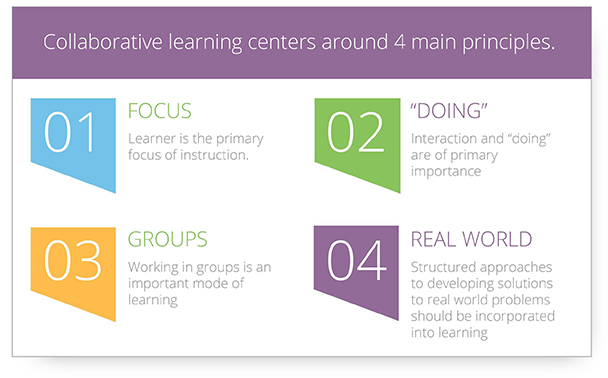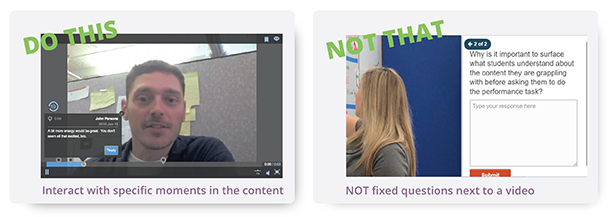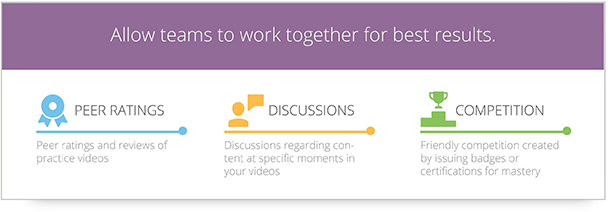It’s always tempting to get excited about a new technology and design a learning program around it. This ignores the basic principles of collaborative learning. Instead, we should take a learner-centered approach and find the technologies that actually support the learner. Online video is no exception to this rule.
As you may be aware, collaborative learning centers around four main principles (Figure 1):
- The learner is the primary focus of instruction
- Interaction and “doing” are of primary importance
- Working in groups is an important mode of learning
- Structured approaches to developing solutions for real-world problems should be incorporated into learning

Figure 1: The four principles of collaborative learning
When designing an eLearning solution, your motivations often involve cost savings, mass distribution of information, learning at scale, and convenience. The first pass at learning online often entails uploading presentations that you would typically use in an in-person setting, adding some learner controls to advance from one content item to the next, adding some quiz questions, and maybe uploading a video recording of the in-person presentation because online video makes the course more engaging. As we all know, this method for eLearning falls flat.
Best practices
Fortunately, today’s technology offers so much more. The interest in using online video for learning is well supported by Richard Mayer’s multimedia learning modality principle: Explaining graphics with audio yields an 80 percent average learning improvement (see References). However, even the highest-quality professionally produced video is passive. Press play, sit back, and watch. Just adding video to an online course doesn’t make the course better. Follow these best practices to get the most collaborative-learning value from your online video use.
1. Record in the first person
At the recent FocusOn Learning 2016 Conference, Dr. Hans de Graaf pointed out that online video is a one-to-one medium (the link opens a recording of his presentation; scrub ahead to about 42:12), giving you an opportunity to keep the learner central to the experience. He advocated for “human” personalization of your recording device. This concept is further supported by Mayer’s personalization principle, based on research by Byron Reeves and Clifford Nass (see References). The research establishes that a personal, conversational style is more effective for learning than formal language is. Research also indicates that using a character to provide instructional advice can improve learning. Fear not! This user-agent character does not need to be a “talking head” to be effective—a human voice is sufficient.
2. Use an environment that supports video interactivity
Standard online video isn’t typically offered in an environment that supports or encourages general interactivity and the other principles of collaborative learning. Developers often drop video into otherwise effective eLearning systems without any connection between moments in the content and the learners. As Mayer emphasizes with the spatial contiguity principle, make the connection between the learner interaction and the content as close as possible (Figure 2).

Figure 2: Make the connection between the learner interaction and the content as close as possible
Once this connection between the learner and moments of video content is made, you can get your learners to interact and react to the content in ways similar to an in-person interaction. For example:
- Start a discussion prior to the start of an example in the video, asking learners to speculate on what will happen next
- Ask learners to choose from a list what the person in the video should do next; jump the learner to a different part of the video depending on his or her response to see how each answer choice might play out
- Ask learners to find and mark a particular content item within a video—for instance, a speech course may request students to identify the main point or transition points, spot the error in a safety video, identify the critical moment in a customer interaction, etc.
You get the idea. Connecting to moments in the video allows you to create interactive engagements similar to those you would normally have with an in-person setting.
3. Give the learner some control
Mayer’s segmenting principle advocates providing learners with some control over their experience. Segment your content into individual steps so that users can move at their own pace. With online video content, segmenting techniques include:
- Making shorter videos to cover each step and sequencing them in a playlist so that users can move at their own pace
- For longer videos, creating a table of contents or chapters to allow users to jump in right where they need to
- Adding questions between topics to determine whether learners can skip over content they already know
4. Combat forgetting
With your active learning techniques embedded in the video content and learner controls in place, you still need to account for getting your learners to retain their new knowledge. The Ebbinghaus forgetting curve indicates that as much as 70 percent of information may be lost after 24 hours. To combat this tendency, you must help your learners encode, store, and retrieve the information. For example:
- Provide online learners with the same tools they use offline to create bookmarks, make notes, and tag the video content
- Schedule video availability to prepare the learner for a lesson, provide the core instruction, and then review materials over multiple days rather than allow for continuous completion of the content
- Require learners to answer questions correctly in order to complete watching content
- Provide printable downloads to post as reminders or use as an offline worksheet
5. Measure results
Collaborative online video learning may sound good in theory, but these days you are being asked to prove efficacy to your management teams. Start by designing your online video training programs with specific learning outcomes in mind. Learners can practice and demonstrate new skills through webcam or smartphone video recordings. Using video-based assignments, you can rate those learner recordings from a common rubric and provide contextual feedback for any moment in a video response. Be sure to use a system that allows you to report out the results of both video assignments and questions asked within the video content.
6. Allow teams to learn together
Working in groups is an important mode of learning, but it’s difficult to do with many video solutions because the content isn’t aware of the learners (see Figure 3). Make sure your video solution supports learner awareness so that you can offer:
- Peer ratings and reviews of practice videos
- Discussions regarding content at specific moments in your videos
- Friendly competition created by issuing badges or certifications for mastery

Figure 3: Your video solution should support learner awareness through these methods
Design a solution to meet your needs
Your real-world problems may be addressed in many different ways. Here are some ideas using collaborative video to get you started. Do you need to:
- Answer questions and provide a forum for practice
and discussion of best practices following an in-person training?
Create a community of practice with review and/or reference videos. Elevate learners to leaders as they demonstrate mastery of skills. Obtain certification through video-based demonstrations of knowledge and skills.
- Minimize subject matter experts’ travel
and time spent training so they can focus on what they do best instead?
Record SME presentations, assign to usergroups, enable Q&A with SMEs through in-video discussion, and add interaction to the videos as described above.
- Expose employees to rarely encountered
situations to ensure they have seen these incidents before they encounter them and
know how to react?
Assign videos in peer groups or cohorts. Seed with in-video discussion questions. Assign response examples to ask people to practice their response to the situation. Require peer reviews and discussion.
- Capture organizational knowledge from a retiring
population?
Require video submissions of demonstrations and presentations using tagging to facilitate curation. Complete expert reviews of the content to pick the best examples in one group; then, publish the content to a library for the organization to explore. You can also combine this with a cohort-assignment approach for peer group learning.
- Level the knowledge base of participants in an on-site
training event so that people are getting the most benefit out of their face-to-face
time?
Provide videos of prerequisite content seeded with questions to gauge knowledge, and direct people to the content they don’t already know. Require them to complete this content before attending so that the in-person portion of training can assume a level playing field. You can also require participants to add an introductory video about themselves and what they expect to get out of the training.
- Require practice and reinforcement
after training to improve retention?
Following a training event, assign review videos with questions at key points to encourage the brain’s storage and retrieval mechanisms. If appropriate, require practice of skills that the employee’s manager or a peer group reviews. Make the reference content and review content available in a library for “just-in-time” retrieval.
Excitement over online video certainly should not drive your learning programs, but I hope these examples and best practices give you some ideas for taking a learner-centered approach to collaborative video.
References
Clark, Ruth. “Six Principles of
Effective e-Learning: What Works and Why.” Learning
Solutions Magazine. 10 September 2002.
http://www.learningsolutionsmag.com/articles/384/six-principles-of-effective-e-learning-what-works-and-why/?utm_campaign=lsmag&utm_medium=link&utm_source=lsmag
de Graaf, Hans.
“Making Video Brain-friendly.” FocusOn
Learning 2016 Conference & Expo. 10 June 2016.
http://www.elearningguild.com/conference-archive/index.cfm?id=7438&from=content&mode=filter&source=sessions&showpage=2&type=FocusOn+2016+Conference+%26+Expo&utm_campaign=fovideo1607&utm_medium=link&utm_source=lsmag
Mayer, Richard E. “Cognitive Theory of Multimedia Learning.” In The Cambridge Handbook of Multimedia Learning, edited by Richard E. Mayer. Cambridge, UK: Cambridge University Press, 2005.
Millis, Barbara J.
“Student Learning Outcomes.” Cornell University Center for Teaching Excellence,
2009.
https://www.cte.cornell.edu/documents/presentations/Student%20Learning%20Outcomes.pdf


